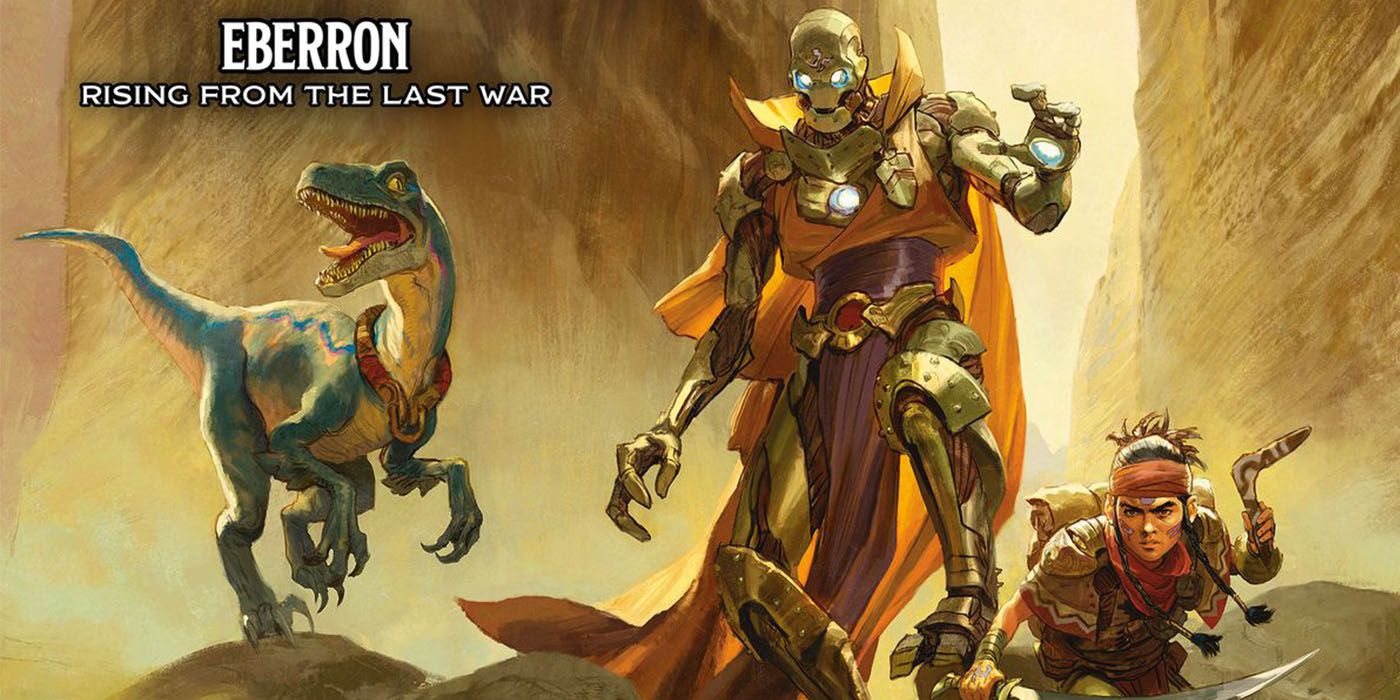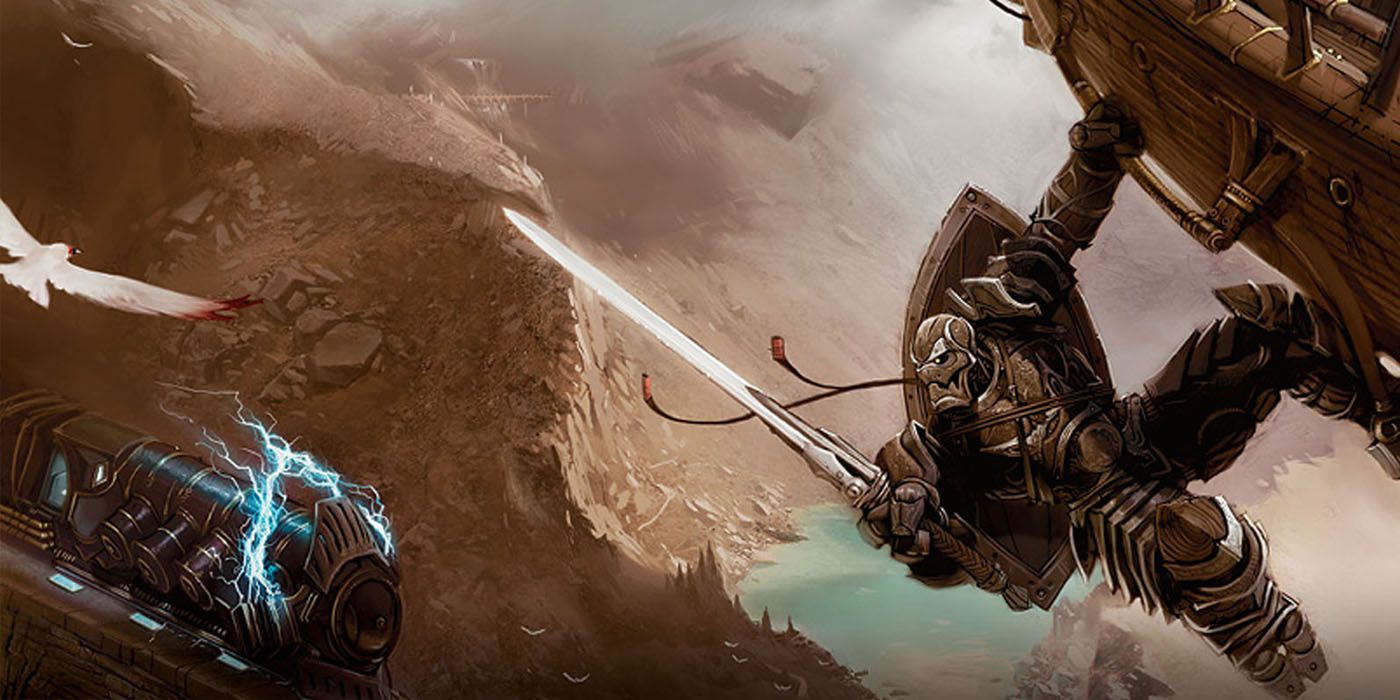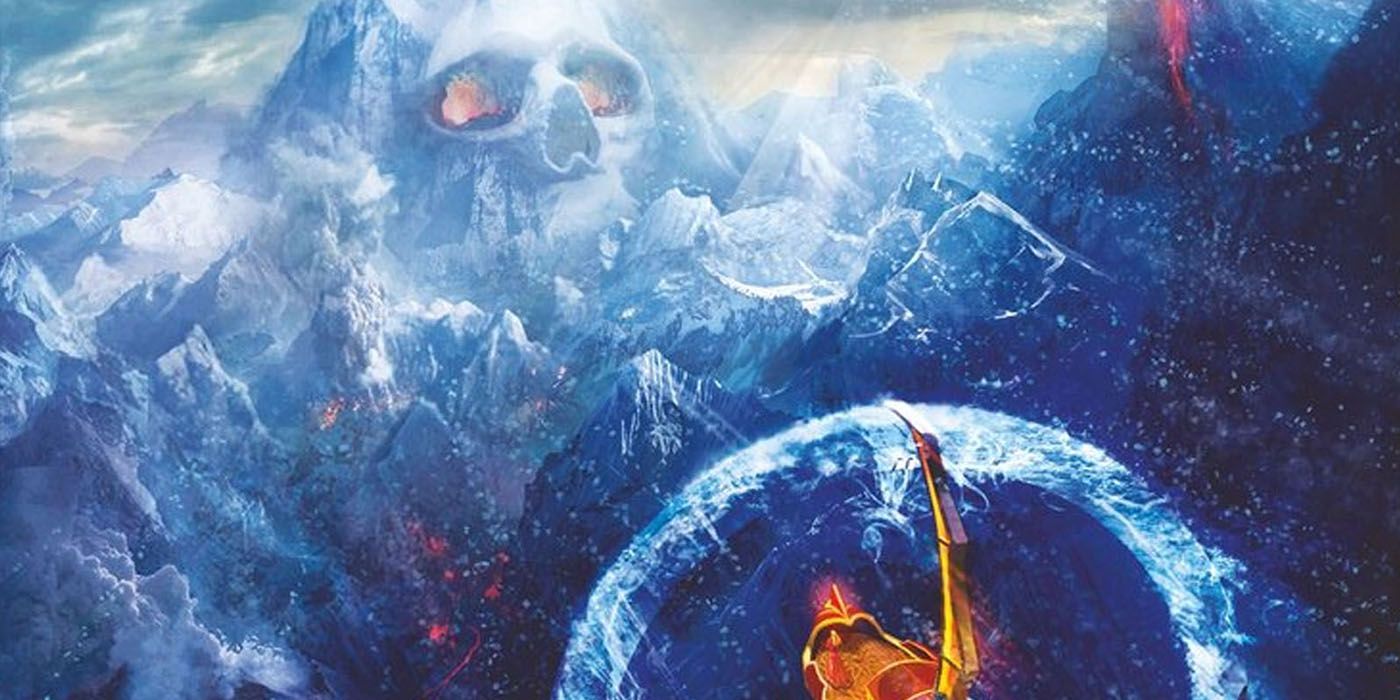Eberron is the second officially supported campaign setting in Dungeons & Dragons 5th edition, after the beloved Forgotten Realms setting (in which the majority of 5th edition sourcebooks take place). Now that there are two full campaign sourcebooks solely dedicated to building adventures in this next setting, it's time to explore what players will get out of an adventure in Eberron.
Of course, Eberron isn't actually new, nor is the Forgotten Realms; they're both old favorites carried over from previous editions of Dungeons & Dragons. The game's 5th edition has been around since 2014, and while a couple of sourcebooks feature adventures technically set in other realms (like Ghosts of Saltmarsh, which takes place in Greyhawk), no other settings have been fully supported outside of the Forgotten Realms until Eberron's sourcebooks began rolling out.
Eberron was first introduced in D&D's 3.5 edition, back in 2004, conceived as a place set in a totally different cosmology than any of the other existing settings. In 2004, Eberron won Best Roleplaying Game Supplement for that year, and it reappeared as a supplemental setting in each following edition of D&D. As of today, 5th edition players can get their hands on both the Wayfinder's Guide to Eberron and Eberron: Rising From the Last War, entering a world vastly different from the more traditional high fantasy-themed Forgotten Realms.
The Genre
As mentioned above, the Forgotten Realms are everything one would expect from a game called "Dungeons & Dragons." It's all swords, sorcery, and weird monsters, whereas Eberron evokes a different mood for players who'd like to switch things up in the next campaign: Eberron is steampunk meets noir-fantasy, with industrial-era-style technology fueled by strange magics unheard of in other lands. There are dragons, sure--the entirety of Eberron is supposedly born from the body of a dragon--but Eberron's uniqueness comes from the blend of magic and mechanics that completely transforms life for its inhabitants. For fans of swashbuckling drama and Indiana Jones-style action, Eberron is the ideal setting.
In fact, some players describe Eberron's unique blend of genres as "dungeonpunk." It's not quite a steampunk or cyberpunk world alone, as Eberron still adopts D&D's rules and magical themes, so adventures can take place in such drastically different locales as a mountain keep inhabited with mystical monks, to industrial skyscrapers in overcrowded cities.
Lower-level magic can be found at every level of society, powering Eberron from the ground up, whereas high-level magic is even more exceptionally rare than it is in the other settings. Metal constructs walk the streets alongside shapeshifters and humans marked by great draconic power. Eberron even boasts an international train system that follows the path of conductor stones, bearing passengers to the cities of Khorvaire and beyond in perfect Old Western fashion. Murder on the Lightning Rail Express, anyone?
The Universe
Traditional D&D gives players an entire multiverse of campaign settings to play around in, from the Forgotten Realms to Planescape and beyond, but Eberron isn't involved with any of that. Eberron throws out the pieces of the rulebook that refer to the layout of the multiverse, adopting its own rules and a brand new layout for its universe.
Classic races like elves and dwarves don't have the same origins as they would in the original multiverse, and Eberron's pantheon of gods are different; one popular debate in Eberron is whether or not gods even exist at all. In the original D&D cosmology, the planes are organized into a configuration called the "Great Wheel." Eberron also includes a number of planes outside of the Prime Material, but they follow a unique layout known as the Orrery. That may sound very obscure to newcomers, but what it means for designing campaigns is essentially this: the four realms of Eberron that are more or less guaranteed to crop up are Eberron itself, the Prime Material on which all adventures begin; Siberys, a plane that resembles an Astral plane, surrounding Eberron; Khyber, which is Eberron's Underdark-adjacent, albeit filled with just as many fiends as underground creatures; and Xoriat, a realm of madness that exists outside of the known universe.
Eberron, Siberys, and Khyber are also the names of Eberron's three great Progenitor Dragons, the aforementioned dragons upon whose backs the universe is built. And in a world originating from ancient draconic magic, some people bear dragonmarks--symbols that magically manifest and grant their hosts augmented physical, mental, spiritual, and emotional powers.
Magic Meets Industry
Eberron's status as the "dungeonpunk" campaign setting also makes it the birthplace of D&D 5th edition's newest playable class: the artificer. Where every other class is defined by spellcasting ability or martial prowess, artificer's key strength is the ability to create items and then infuse them with magic. Generally, an artificer's intelligence levels are right on par with a wizard's but rather than channeling their spells using a book and their own two hands, artificers channel spells through their inventions, which makes for some pretty interesting creations! That also means that artificers can build nonmagical tools (which still come in plenty handy, as any player can attest) and attune to more magical items than any other class.
There are already three subclass choices for artificers: first, the alchemist, who specializes in potion-making and expanded healing. They've also got the signature ability to create an Experimental Elixir, which grants temporary hit points and a random beneficial effect. Then there's the artillerist, a demolition expert through and through, who wields their heavy damage-dealing Eldritch cannon and regularly spits fire at enemies. Their special cannon can actually summon multiple boons, adding magical force and shields to the already established firepower.
Lastly, there's the battle smith, more combat-oriented like the artillerist, but with a focus on defense rather than dealing damage. Battle smiths have magical martial weapons and, best of all, a robot dog backing them up. What's not to like?
The Adventurous Possibilities
Now that Eberron's basic layout has been covered, it's time to answer one last question: what grand adventures are primed for use within the expansive Eberron universe? Not only does the answer cover a number of events currently unfolding across the continents of Eberron, but also illustrates the different playable races unique to the setting and their roleplaying options.
Khorvaire is the most heavily-explored of Eberron's lands, making it the most likely candidate for an adventure setting--though of course, DMs ready for some home-brewing should be more than able to explore elsewhere. However, Khorvaire has no shortage of adventure hooks: this is the continent on which the Last War was fought, which has thematic parallels to World War I. As such, Eberron's Rising From the Last War sourcebook for 5e explores life in the aftermath, where the war has ended but discord still runs rampant. The conflict led to the creation of one Eberron-specific playable race, the warforged.
Warforged are living metal constructs, newly freed from their war-focused world and facing some delicious existential questions about artificial life and whether or not it can flourish when not obeying the singular command to destroy everything. In addition to warforged walking its streets, Khorvaire is also populated by changelings, the offspring of humans and doppelgangers with the ability to change their appearance, albeit not as extensively as a full doppelganger (which means a changeling rogue build would absolutely rule deception and infiltration-related quests). Then there are shifters, a race born from the union of a human and a lycanthrope. That's right, Eberron has half-werewolves, complete with bestial senses and partial shapeshifting abilities.
Inhabiting the continent of Sarlona an ocean away from Khorvaire, Eberron's final unique playable race is the Kalashtar. They're another hybrid-type race, appearing on the surface to merely be ethereally beautiful humans when in fact they're the product of "planar entities" merging with a human host. Kalashtar, as the descendants of such a merger, possess natural psionic powers, and their native Sarlona offers an alternative to the magic-industrial atmosphere of Khorvaire; instead, Sarlona is a battle-scarred land of metaphysical wonders. Oh, and there are three mysterious guardian dragons living in at the top of a mountain, just to add to the intrigue.
While separate from most of Khorvaire's drama, Sarlona has plenty of its own: kalashtar are a hunted race, shuttered into their monastic country of Adar and constantly besieged by their Inspired enemies in the neighboring nation of Riedra. Still, those who want to play kalashtar in a campaign based elsewhere in Eberron can do so without disrupting the setting's narrative; small numbers of kalashtar do inhabit cities across Khorvaire, quietly continuing their battle against the Inspired even far from home. And for DMs about to run a campaign but unsure of where to start in Eberron's brave new world, not to worry: the latest sourcebook, Rising From the Last War, also comes with plot hooks and adventure suggestions to both use and build off of.
Regardless of what character-type players choose, or whichever land the DM decides to explore, Eberron's rich tapestry of civilization can support just as many varied campaign themes as its high-fantasy equivalent in the Forgotten Realms. With a basic understanding of Eberron's (admittedly complex) structure, interested players can get started and conquer Dungeons & Dragons' 5th edition's latest supported setting with ease. Just remember to gather the party before venturing forth.



